International Contemporary Random Chess
International Contemporary Random Chess (ICRC) is a 10x10 variant inspired by English Random Chess and Contemporary Random Chess.
Benjamin Clark proposed English Random Chess in 2004. Simply stated English Random Chess is a variant played with the pieces of a standard chess set, on a Polish or International Draughts (Checkers) 10x10 board (below right).
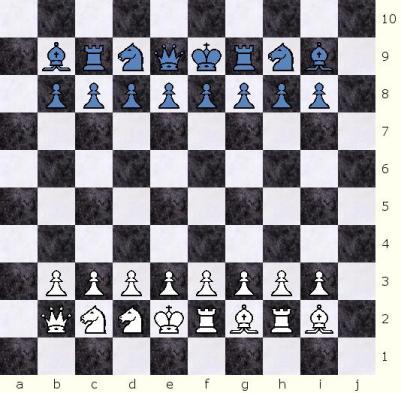
In English Random Chess (ERC) the pawns are placed on the players 3rd rank, with the pieces randomly placed behind the pawns. There are no men on the first and last files or ranks. (see sample position above left)
There are no restrictions in ERC regarding the random placement of the pieces behind the pawns, any combination is valid, and there is no symmetry between the two sides. Each side has their own random setup. There are 5,040 possible setups per side and 25,401,600 possible different games that can be played (5,040 x 5,040).
Castling is possible, provided the random position allows it (i.e. the King starts between the rooks), and Bishops can be on the same color squares. In the sample English Random Chess position above Black is able to castle (but White is not), and White has both Bishops on the light color squares.
Contemporary Random Chess is a 'Modern' chess variant with a random setup (that allows both Bishops to start up on squares of the same color) and reverse symmetry between both armies.
 ..
.. 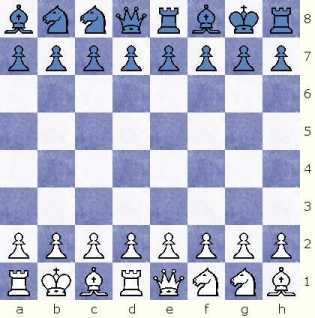
Contemporary Random Chess allows symmetric (short) castling to either side of the board, and the Bishop Adjustment Rule to allow players to move a Bishop to the opposite color squares in those random positions where both Bishops start on the same color squares.
International Contemporary Random Chess applies all the 'Modern' principles to English Random Chess, limiting the opening setups to the 2,520 different reverse symmetric starting positions of Contemporary Random Chess, and formalizing a castling rule. ICRC also inherits the Bishops Adjustment Rule.
Setup
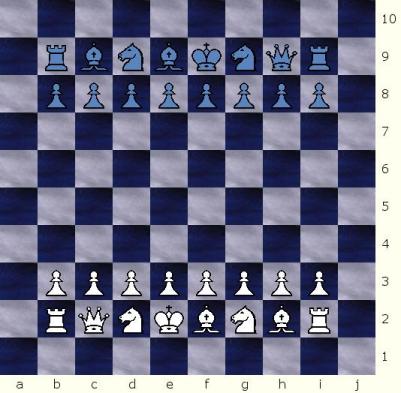

The pawns are placed on the players 3rd rank, with the pieces randomly placed behind the pawns. There are no men on the first and last files or ranks.
All pieces are randomly placed in the players' second rank, with the only restriction that the King must be between the two rooks (this is to allow for the castling rule). It is possible for both Bishops to be on the same color squares (dark or light squares).
There are 2,520 different legal starting positions in International Contemporary Random Chess.
There is a Bishop Adjustment rule that is in effect only in games when both Bishops start on the same color squares in the initial random setup. This rule allows players to move one of the Bishops to the opposite color, if they so desire.
Reverse Symmetry
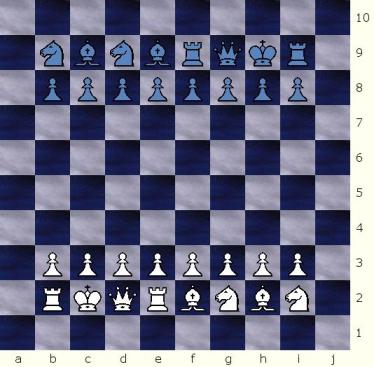
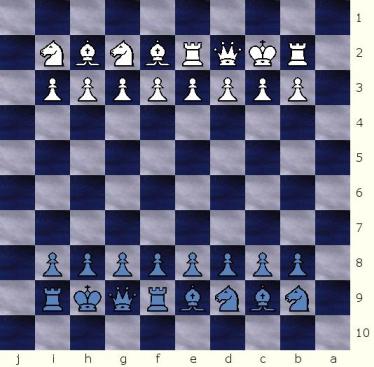
The opponents’ pieces are placed with reverse symmetry (White’s piece at b2 is equivalent to Black’s i9, White’s c2 to Black’s h9, White’s d2 to Black’s g9, White’s e2 to Black’s f9, and so on…). Both White and Black players have the same view of the board, both of their own pieces, as well as for the enemy army.
Pieces
Orthodox Chess pieces are exclusively used.Rules
External image links detected!
You know what would look worse on your page than this big, ugly warning? Broken image links. If you're the author, please make sure that doesn't happen to this page by replacing the following external graphic images with local copies.
Array
(
[0] => http://frcec.chess960.info/FRC-Castling_files/image051.png
)
Pawn promotion takes place when pawns reach their 10th rank.
Castling
The International Contemporary Random Chess castling
rules are based in the Fischer Random Chess rules.
In ICRC, depending on the pre-castling position on the castling King and Rook, the castling manoeuvre is performed by one of these four methods:
- Double-move castling: By on one turn making a move with the king and a move with the rook.
- Transposition castling: By transposing the position of the king and the rook.
- King-move-only castling: By making only a move with the king.
- Rook-move-only castling: By making only a move with the rook.
Castling the King and Rook will be placed as if the player had castled short in Orthodox Chess, both to either side of the board. There is no long castling (O-O-O) in ICRC.
Thus, after c-castling (notated as O-Oc), the King is on the c-square (c2 for White and c9 for Black) and the Rook is on the d-square (d2 for White and d9 for Black). After h-castling (notated as O-Oh), the King is on the h-square (h2 for White and h9 for Black) and the Rook is on the g-square (g2 for White and g9 for Black). h-castling (O-Oh) is identical to Ortodox Chess short castling (O-O).
This table shows where the King and Rook end up and the notation for each type of castling.
| White castles a-side | c-castling | O-Oc | Kc2, Rd2 |
|---|---|---|---|
| White castles j-side | h-castling | O-Oh | Kh2, Rg2 |
| Black castles a-side | c-castling | O-Oc | Kc9, Rd9 |
| Black castles j-side | h-castling | O-Oh | Kh9, Rg9 |
However, castling may only occur under the following conditions, which are extensions of the standard rules for castling:
- Unmoved: The King and the castling Rook must not have moved before in the game, including a previous castling or a Bishop Adjustment.
- Un-attacked: All of the squares between the king's initial and final squares (including the initial and final squares) must not be under attack by any opposing piece.
- Vacant: All the squares between the king's initial and final squares (including the final square), and all of the squares between the rook's initial and final squares (including the final square), must be vacant except for the king and castling rook.
- Castling cannot capture any pieces.
- The king and castling rook cannot "jump" over any pieces other than each other.
- A player may castle at most once in a game.
- If a player moves his king or both of his initial rooks without castling, he may not castle during the rest of the game.
- In some starting positions, the king or rook (but not both) do not move during castling.
- In some starting positions, castling can take place as early as the first move.
- The king may not be in check before or after castling.
- The king cannot move through check.
- The king cannot jump over his own rook if and when said rook stands on a “checked†square. This point is best ilustrated by the sample Fischer Random Chess (Chess960) position below where it's illegal for White to g-castle (O-O) with it's e-Rook, as the King would need to jump over an attacked square. Even though the e-square is occupied by a Rook, it is under attack (or 'checked') by Black's Rook on e8.

- A King that has swapped places with a Bishop according to the Bishop Adjustment rule can no longer do castling for the rest of the game.
- A Rook that has swapped places with a Bishop according to the Bishop Adjustment rule can no longer castle with the King.
- Castling in ICRC is symmetric to either side of the board. ICRC Castling is like the Orthodox short castling (O-O) but to either side.
The Bishop Adjustment Rule
In those positions where the Bishops start up in the same color squares (either both on dark or light squares), players on their turn, are allowed to convert one (and only one) of their Bishops to the opposite color square by swapping places with any piece adjacent to them. Neither the Bishop nor the piece to be adjusted with may have moved before the Bishop swap. The Bishop adjustment will count as a single turn, and a move for both the Bishop and the piece swapped with.The Bishop Adjustment Rule is optional, and a player is not forced to use it. A player may choose to play with his Bishops on the same color squares if he so desires, even if his opponent chooses to adjust one of his Bishops.
Note that the Bishop Adjustment rule has the following consequences in ICRC:
- A Bishop on a corner may only adjust with the one piece adjacent to it.
- The Bishop is allowed to swap places with a Knight, the Queen, a Rook, and also with the King!
- If the Bishop Adjusts with a Rook, that rook will be considered to have moved, and King Castling with that rook will no longer be possible. King Castling with the other Rook will still be possible provided neither the second Rook nor the King have moved.
- If the Bishop Adjusts with the King, the King will be considered to have moved, and King Castling will no longer be available for the rest of the game.
- When adjusting with the King, the Bishop Adjustment is considered to be a “Bishop†move, and not a King move that enables a player to move out of check. If the King is in check, it is not legal to move out of check with a Bishop Adjustment.
Notes
Sample Games
The First ICRC game ever!
ICRC Position - QRKNBRBNGary Gifford (USA) - José Carrillo (CAN)
CV Game Courier, December 2008

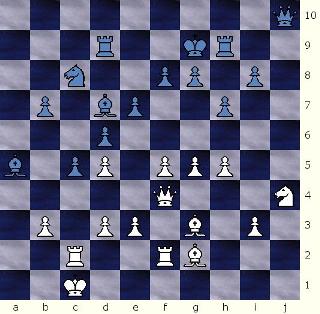
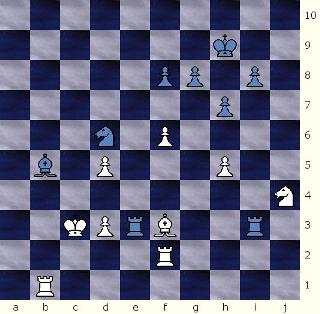
1. g5 d6 2. Qa3 e7 3. Nh4 Nc7 4. Nd4 Be<=>N 5. f5 Bd7 6. Bf<=>R Qj8 7. Ndf3 Nb5 8. Qb4 c6 9. Qf4 Nc8 10. Nd4 Nxd4 11. cxd4 b7 12. d5 c5 13. Ni6 Qj6 14. h5 h7 15. Nj4 Bd8 16. Bg3 Ba5+ 17. Kc1 Qj10! (Qa1# mate threat!, diagram above in the middle) 18. f6 Ra9 19. Kd1 O-Og 20. Bf3 exf6 21. Qxf6 Qxf6 22. gxf6 Bd8 23. e5 dxe5 24. Bxe5 Ra3 25. Rb2 Re9 26. Bc3 Ra1+ 27. Kc2 Ri1 28. b4 cxb4 29. Rxb4 Rxi3 30. Rb7 Ba4+ 31. Kd2 Nd6 32. Rb4 Bb5 33. Kc2 Ba5 34. Rb1 Bxc3 35. Kxc3 Re3!! (Brilliant! Simultaneously creating double-attacks on the Bishop at f3 and the pinned d3-pawn. White is in trouble, diagram above at right) 36. Be2?! (nothing works well for White now, this move sets up the final blow) Ne4+!! 0-1 (Knight fork check taking advantage of the pinned d3-pawn, the f2-Rook is now gone, final position below)

Game Courier Preset
International Contemporary Random Chess presetGame Courier Logs
Game Courier Logs for Games of International Contemporary Random ChessTo see actual games that have been played on-line, follow the link above.
International Contemporary Random Chess (CRC) was created by José Manuel Carrillo-Muñiz, from Puerto Rico in 2008.
Chess Variants by the Author:
- Modern Random Chess (9x9)
- Contemporary Random Chess (8x8)
- Prime Ministers Chess (9x8)
- Modern Capablanca Random Chess (10x8)
- Modern English Random Chess (10x10)
- Pseudo-Modern Random Chess (9x9)
- Chess8400 (9x9)
- Prime Ministers Contemporary Random Chess (8x8)
- Prime Ministers Random Chess (9x8)
- International Contemporary Random Chess (10x10)
- International Fischer Random Chess (10x10)
- Courier Chess Moderno (12x8)
- Mini Courier Chess Moderno (10x8)
- Silver Elephant Chess (10x8)
- Modern Ministers Courier Chess (11x8)
- Ajax Complex
- Ajax Chess (10x10)
- Ajax Orthodox Chess (8x8)
- Ajax Random Chess (8x8)
- Ajax Modern Random Chess (9x9)
- Ajax Falcon Chess (10x8)
- Ajax-Capablanca Chess (10x8)
- Partnership Chaturanga (8x8)
Other Pages by the Author:
- How to Generate Random Positions
- The Bishop Adjustment Rule
- The Modern Principles
- Reverse Symmetry
- The Prime Minister
- The Courier Elephant
- The 10x8 Variants
- Modern Chess Preset
- Makruk (Thai Chess) Preset
 This 'user submitted' page is a collaboration between the posting user and the Chess Variant Pages. Registered contributors to the Chess Variant Pages have the ability to post their own works, subject to review and editing by the Chess Variant Pages Editorial Staff.
This 'user submitted' page is a collaboration between the posting user and the Chess Variant Pages. Registered contributors to the Chess Variant Pages have the ability to post their own works, subject to review and editing by the Chess Variant Pages Editorial Staff.
By Jose Carrillo.
Web page created: 2008-08-03. Web page last updated: 2008-08-05
